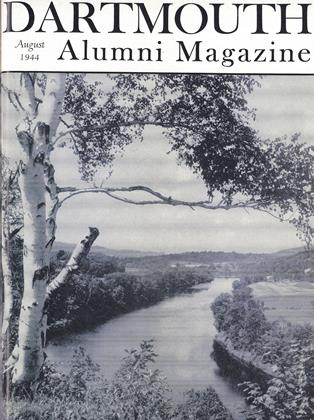Change of Mind
To THE EDITOR:
Remember way back in 1939 when the movie "Winter Carnival" finally showed up at the Nugget and was "shown up" in TheDartmouth and every place on campus? I think it was Johnny Hess wrote the "Day by Day" on it and, if I remember rightly, he dug deep to scathe Schulberg and Wanger and all Dartmouths who had anything to do with it.
At the time I agreed with him. But, take it from a guy who knows, "Winter Carnival" was probably the greatest movie ever produced. No Hollywood pap, that—as the boys used to say. Tonight I saw it again. After five years of mellowing, "Winter Carnival" appeared to be a great cinema, deserving of every Oscar in the book. At this Pacific outpost, movies arrive late and for once I was grateful.
It was nostalgic and it was corn, but if n and c can make me feel like that I'll take it every time. I probably ruined what there was of the movie by explaining every background shot to the guys around me and I was certain I recognized half my class in that mass skiing scene. "Winter Carnival" was a great movie and if I ever see Hess again I'm going to tell him so. Meantime, I thought I'd let you know.
c/o Postmaster
San Francisco, Calif.
Stubbie Pearson
The following letter, received by PresidentHopkins, is printed here as an ALUMNI MAGAZINE communication because of the widespread alumni interest in the heroic death ofLt. (jg) Charles M. (Stubbie) Pearson '42:
DEAR PRESIDENT HOPKINS:
By this time you will have heard or shall shortly hear that Stubbie Pearson was killed in the Palau raid where the Navy sank close to 38 ships and destroyed approximately 300 planes.
I was here at this island base when Stub's carrier left, and I had an appointment to meet him when he returned from this action, so that when his ship returned I, too soon, heard of the tragedy.
Stubbie Pearson, being the figure that he was, I thought that the College might like to know the actual details, so I went aboard his ship and made inquiries amongst his squadron mates.
First, however, I must assume you know little about the technical aspects of dive-bombing and explain in brief the fundamentals, for Stub was a dive-bomber.
A dive-bomber pilot is comparatively safe if he pulls out of his dive at 2500 ft. or above, for then the range of the anti-aircraft guns is so great that his chances of being hit are small. If, however, he dives below this altitude, his risk increases greatly with each hundred feet, but his chances of hitting the target increase correspondingly.
The Navy and Marine Corps suggest a safe release and pullout altitude, but leave the decision to the discretion of the pilot.
Stubbie was seen to dive on a Japanese destroyer and at 1500 ft. was still going straight down, for one pilot reported that as he pulled out at 1500 ft. Stub went by him still going down. He must have been struck at this point or shortly thereafter, for the nose of his plane started to come up but at about 900 ft. he must have lost consciousness for the plane nosed over sharply and went straight in at terrific speed. There is no possibility of his having survived. In the shower of bombs no one knows which bomb was Stubbie's, but the destroyer was hit and sunk.
You may be interested to know that Stubbie's shipmates aboard the carrier held him in even greater esteem than we all did in the College, if that is possible.
Ist Lieut., USMCR.
P.S. Stub Pearson's tour of duty was almost over and this might have been his last action, for he went through the Truk, Tinian, Saipan, Ponape, Rabaul, Kavieng, and other raids.
April 8, 1944
 View Full Issue
View Full Issue
More From This Issue
-
 Article
ArticleA TEACHING LIBRARY
August 1944 By NORMAN K. ARNOLD -
 Article
ArticleTHE HISTORIC COLLEGE
August 1944 -
 Article
ArticleALUMNI OFFICERS MEET
August 1944 -
 Article
ArticleTHE 50-YEAR MESSAGE
August 1944 By REV. CHARLES C. MERRILL '94 -
 Class Notes
Class Notes1904
August 1944 By DAVID S. AUSTIN II, THOMAS W. STREETER -
 Article
ArticleMAN WITH COW SENSE
August 1944 By A. P.
Letters to the Editor
-
 Letters to the Editor
Letters to the EditorLetters to the Editor
DECEMBER 1930 -
 Letters to the Editor
Letters to the EditorLETTERS
DECEMBER 1958 -
 Letters to the Editor
Letters to the EditorLetters to the Editor
OCTOBER 1965 -
 Letters to the Editor
Letters to the EditorLetters to the Editor
MARCH 1967 -
 Letters to the Editor
Letters to the EditorLetters to the Editor
MAY 1971 -
 Letters to the Editor
Letters to the EditorLetters
DECEMBER 1982


